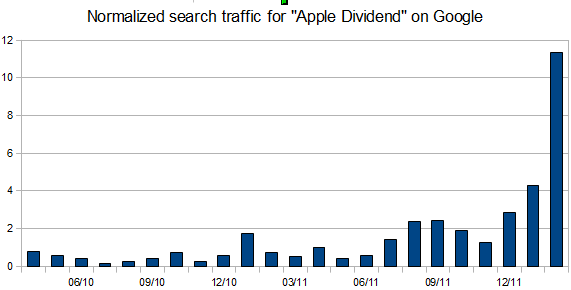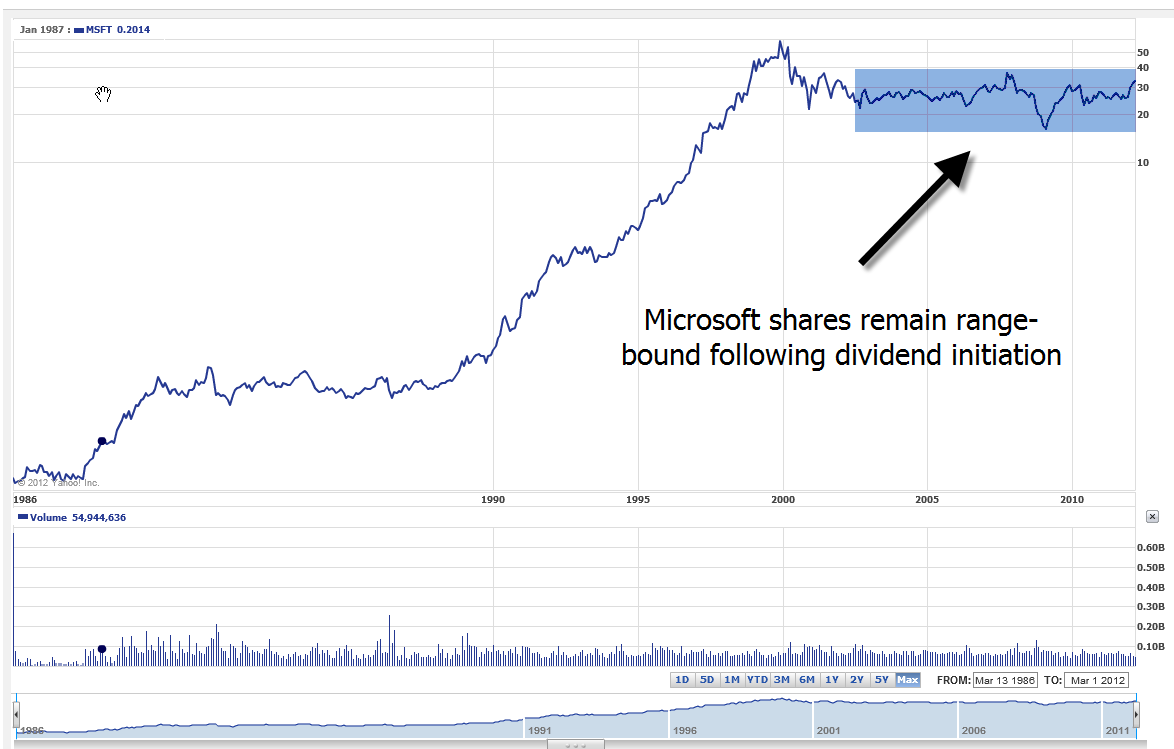by Michael Tarsala
A big Apple dividend or stock buyback could in theory make the stock all the more attractive. In reality, it may be viewed as admission by top brass that it cannot manage such a large and valuable company effectively.
The idea of Apple returning some of its $97 billion cash horde to investors is gaining steam. There have been a number of insightful posts about it, and it’s increasingly a topic of conversation. One reflection of its popularity is the chart below, which shows how many times “Apple dividend” appeared in U.S. Google searches on a monthly basis.

Source: Google Inc.
Some are all for it
Cogent aguments are being made that returning some of its massive horde back to shareholdes would not only be just, but could make Apple an even better investment.
Think about it: Apple already has so much going for it. It has killer growth, loved products, a rsepected management team and the built-in inflation resistance of having very few costs tied to fuel prices. Add a dividend as well, and voila! Apple appeals to growth investors, income-seekers, and even those fearing commodity inflation!
There is one problem with that logic. It also may be seen as management throwing in the towel on doing something a lot more productive with that money.
Buybacks have not worked
There’s reason to think that neither move would create shareholder value, and that a buyback, in particular, could be a bad omen.
Reserchers at the University of Chicago concluded that management teams tend to increase stock repurchases when earnings fall short of maintaning past EPS growth rates (in other words, a buyback can help cover up a growth slowdown for a while).
So if Apple does decide on a buyback, it may be interpreted as management’s way of signaling that its best days of growth are behind it.
Richard Lee at Thomson Reuters had a different, but similarly dismal conclusion about buybacks in late 2010, saying that a six-year study of them showed almost no material impact for stocks.
A dividend announcement could be a snoozer
As for a dividend, that may be a ho-hum event. One of the classic finance theorems suggests that in an efficient market, a company’s dividend policy doesn’t affect its value. Financing methodologies don’t have a bearing on that sort of thing.
Another shadow of doubt is that dividends do not appear to be driving extra value for other tech stocks, as seen in the table below.
 The cap-weighted performance of the 79 tech stocks in the State Street SPDR ETF rose 21.9% from a year ago, based on data from Finviz and Yahoo Finance. The 57 stocks that did not pay a dividend or had a less than 2% dividend yield rose 24.6% (not adjusted for those dividends). The 22-stock subset in that group that paid a dividend had a cap-weighted gain of 15.7%.
The cap-weighted performance of the 79 tech stocks in the State Street SPDR ETF rose 21.9% from a year ago, based on data from Finviz and Yahoo Finance. The 57 stocks that did not pay a dividend or had a less than 2% dividend yield rose 24.6% (not adjusted for those dividends). The 22-stock subset in that group that paid a dividend had a cap-weighted gain of 15.7%.
Yes, Apple’s huge gain skews thing. But even when taking Apple completely out of the non-dividend payers, there is not a major edge for the dividend group. The performance difference is about 1% (up 14.3% for the non-dividend group vs. the 15.7% for dividend payers).
There were only two stocks with a dividend of 2% or more that outperformed the tech group at-large on a cap-weighted basis: Intel and Microsoft.
Interestingly, neither of those stocks have lit the world on fire since their last dividend initiations.
Microsoft began paying a dividend in 2003. It was a heralded move by many investors at the time. But the dividend did nothing to help the company as it struggled to define its next-generation Internet strategy, or to help it foresee the rise of Google or Facebook. The stock continued to move sideways in a channel for another nine years.

Source: Yahoo Finance
And since resuming its long-time dividend in 2004, Intel has boosted cumulative earnings just 8.1% a year, based on historical company data — not bad at all in a difficult environment, but far less than the strong double-digit growth it posted in its heyday.
Perhaps Apple’s management team does have a great plan to create value with its cash, either with broad new R&D initatives, acquisitions, or new business ventures.
I hope so. Any distribution to shareholders is open to interpretation. And one such interpretation that Apple may be unable to find a good enough business idea to justify bold new spending.
Note: There is still time to register for the free NextInvest Virtural Conference on March 20 and 21. Guests expected to attend include David Whitmore, senior strategist at ETrade; Lee Hull, founder of Hull Capital Management and author, “Less Risk, More Return”; Christopher Henwood, commodities trading expert and former VP of Goldman Sachs affiliate J. Aron; Tadas Viskanta, editor of Abnormal Returns; Howard Lindzon, CEO of Stocktwits; Brian Bolan, equity strategist at Zacks.com; and Patrick O’Hare, chief market analyst at Briefing.com.



